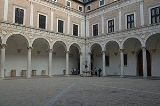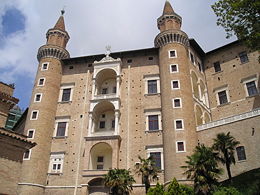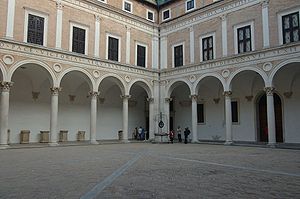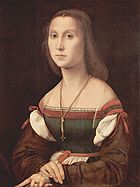
Palazzo Ducale, Urbino
Encyclopedia

Renaissance
The Renaissance was a cultural movement that spanned roughly the 14th to the 17th century, beginning in Italy in the Late Middle Ages and later spreading to the rest of Europe. The term is also used more loosely to refer to the historical era, but since the changes of the Renaissance were not...
building in the Italian
Italy
Italy , officially the Italian Republic languages]] under the European Charter for Regional or Minority Languages. In each of these, Italy's official name is as follows:;;;;;;;;), is a unitary parliamentary republic in South-Central Europe. To the north it borders France, Switzerland, Austria and...
city of Urbino
Urbino
Urbino is a walled city in the Marche region of Italy, south-west of Pesaro, a World Heritage Site notable for a remarkable historical legacy of independent Renaissance culture, especially under the patronage of Federico da Montefeltro, duke of Urbino from 1444 to 1482...
in the Marche
Marche
The population density in the region is below the national average. In 2008, it was 161.5 inhabitants per km2, compared to the national figure of 198.8. It is highest in the province of Ancona , and lowest in the province of Macerata...
. One of the most important monuments in Italy, it is listed as UNESCO World Heritage Site.
History

Luciano Laurana
Luciano Laurana was a Croatian or Italian architect and engineer from the historic Vrana settlement near the town of Zadar in Dalmatia, Croatia. After education by his father Martin in Vrana settlement, he worked mostly in Italy during the late 15th century...
, an architect from Dalmatia
Dalmatia
Dalmatia is a historical region on the eastern coast of the Adriatic Sea. It stretches from the island of Rab in the northwest to the Bay of Kotor in the southeast. The hinterland, the Dalmatian Zagora, ranges from fifty kilometers in width in the north to just a few kilometers in the south....
who had been influenced by Brunelleschi
Filippo Brunelleschi
Filippo Brunelleschi was one of the foremost architects and engineers of the Italian Renaissance. He is perhaps most famous for inventing linear perspective and designing the dome of the Florence Cathedral, but his accomplishments also included bronze artwork, architecture , mathematics,...
's cloisters in Florence, designed the façade, the famous courtyard and the great entrance staircase. Laurana's light and noble arcaded courtyard at Urbino rivals that of the Palazzo della Cancelleria
Palazzo della Cancelleria
The Palazzo della Cancelleria is a Renaissance palace in Rome, Italy, situated between the present Corso Vittorio Emanuele II and the Campo de' Fiori, in the rione of Parione...
in Rome as the finest of the Renaissance. Overcoming the exigencies of the clifflike site, which made an irregular massing of architecture necessary, from the 1460s onwards Laurana created what contemporaries considered the ideal princely dwelling. Many of the refined Early Renaissance carved details are so similar to features in paintings by Piero della Francesca
Piero della Francesca
Piero della Francesca was a painter of the Early Renaissance. As testified by Giorgio Vasari in his Lives of the Artists, to contemporaries he was also known as a mathematician and geometer. Nowadays Piero della Francesca is chiefly appreciated for his art. His painting was characterized by its...
that scholars have debated his possible input in the execution of Laurana's plan.
After Laurana's departure from Urbino in 1472, works were continued by Francesco di Giorgio Martini, who was mainly responsible for the façade decoration. The portals and the window sculptures were executed by the Milanese Ambrogio Barocci, who was also the decorator of the interior rooms. In high, plainly stuccoed rooms the richly sculptured doorways, chimneys and friezes created by Barocci, Domenico Rosselli
Domenico Rosselli
Domenico Rosselli was an Italian sculptor.Details of Rosselli's life are limited, but he seems to have trained in Florence. He is best known for his work on many of the friezes, sculpted doorways and decorative fireplaces in the Ducal Palace in Urbino, most particularly the in the...
, and their workshops stand out. After the death of Duke Federico (1482), the construction was left partially unfinished. The second floor was added in the first half of the following century by Girolamo Genga
Girolamo Genga
Girolamo Genga was an Italian painter and architect of the late Renaissance, Mannerist style.- Biography :Genga was born in 1507 in a region near Urbino. According mainly to Giorgio Vasari's biography, by age thirteen Genga had gained an apprenticeship in Orvieto under Luca Signorelli...
.
The Ducal Palace is famous as the setting of the conversations which Baldassare Castiglione
Baldassare Castiglione
Baldassare Castiglione, count of was an Italian courtier, diplomat, soldier and a prominent Renaissance author.-Biography:Castiglione was born into an illustrious Lombard family at Casatico, near Mantua, where his family had constructed an impressive palazzo...
represents as having taken place in the Hall of Vigils in 1507 in his Book of the Courtier.
The palace continued in use as a government building into the 20th century, housing municipal archives and offices, and public collections of antique inscriptions and sculpture (the Galleria Nazionale delle Marche, see below). Restorations completed in 1985 have reopened the extensive subterranean network to visitors.
Studiolo and twin chapels
The Ducal Palace featured several rooms that reflect Federico's devotion to Classical and humanistic studies and served his daily routine, which included visiting the palace's lararium and reading Greek literatureGreek literature
Greek literature refers to writings composed in areas of Greek influence, typically though not necessarily in one of the Greek dialects, throughout the whole period in which the Greek-speaking people have existed.-Ancient Greek literature :...
. These learned and explicitly pagan touches were atypical of a medieval palazzo.
Studiolo
A central element in this plan is the studiolo (a small study or cabinet for contemplation), a room measuring just 3.60 x 3.35m and facing away from the city of Urbino and towards the Duke's rural lands. Its beautifully executed intarsiaIntarsia
Intarsia is a form of wood inlaying that is similar to marquetry. The term is also used for a similar technique used with small, highly polished stones set in a marble matrix .- History :...
work, surrounding the room's occupant with trompe-l'oeil shelves, benches, and half-open latticework
Latticework
Latticework is a framework consisting of a criss-crossed pattern of strips of building material, typically wood or metal. The design is created by crossing the strips to form a network...
doors displaying symbolic objects representing the Liberal Arts
Liberal arts
The term liberal arts refers to those subjects which in classical antiquity were considered essential for a free citizen to study. Grammar, Rhetoric and Logic were the core liberal arts. In medieval times these subjects were extended to include mathematics, geometry, music and astronomy...
, is the single most famous example of this Italian craft of inlay. The benches hold musical instruments, and the shelves contain representations of books and musical scores, scientific instruments (including an astrolabe
Astrolabe
An astrolabe is an elaborate inclinometer, historically used by astronomers, navigators, and astrologers. Its many uses include locating and predicting the positions of the Sun, Moon, planets, and stars, determining local time given local latitude and longitude, surveying, triangulation, and to...
and an armillary sphere
Armillary sphere
An armillary sphere is a model of objects in the sky , consisting of a spherical framework of rings, centred on Earth, that represent lines of celestial longitude and latitude and other astronomically important features such as the ecliptic...
), study furnishings (including a writing desk and an hourglass), weapons and armor, and various other objects (e.g. parrots in cages and a mazzocchio).
The studiolo also features iconic representations of several persons, both contemporary and historical. On the intarsia panels are depicted statues of Federico in scholarly attire and of Faith, Hope, and Charity. Above the intarsia panels are portraits of great authors by Joos van Wassenhove
Joos van Wassenhove
Justus van Gent , Justus or Jodocus of Ghent, or Giusto da Guanto was an Early Netherlandish painter who later worked in Italy....
(with reworking by Pedro Berruguete
Pedro Berruguete
Pedro Berruguete was a Spanish painter; his art is regarded as a transitional style between gothic and Renaissance. Born in Paredes de Nava, Spain, he went to Italy in 1480 and worked in Federico III da Montefeltro's court in Urbino, where he could see some works by Melozzo da Forlì...
):
| North wall | |||
|---|---|---|---|
| Plato Plato Plato , was a Classical Greek philosopher, mathematician, student of Socrates, writer of philosophical dialogues, and founder of the Academy in Athens, the first institution of higher learning in the Western world. Along with his mentor, Socrates, and his student, Aristotle, Plato helped to lay the... |
Aristotle Aristotle Aristotle was a Greek philosopher and polymath, a student of Plato and teacher of Alexander the Great. His writings cover many subjects, including physics, metaphysics, poetry, theater, music, logic, rhetoric, linguistics, politics, government, ethics, biology, and zoology... |
Ptolemy Ptolemy Claudius Ptolemy , was a Roman citizen of Egypt who wrote in Greek. He was a mathematician, astronomer, geographer, astrologer, and poet of a single epigram in the Greek Anthology. He lived in Egypt under Roman rule, and is believed to have been born in the town of Ptolemais Hermiou in the... |
Boethius |
| St. Gregory the Great | St. Jerome | St. Ambrose | St. Augustine Augustine of Hippo Augustine of Hippo , also known as Augustine, St. Augustine, St. Austin, St. Augoustinos, Blessed Augustine, or St. Augustine the Blessed, was Bishop of Hippo Regius . He was a Latin-speaking philosopher and theologian who lived in the Roman Africa Province... |
| West wall | East wall | ||
| Pietro d'Abano Pietro d'Abano Pietro d'Abano also known as Petrus De Apono or Aponensis was an Italian philosopher, astrologer and professor of medicine in Padua. He was born in the Italian town from which he takes his name, now Abano Terme. He gained fame by writing Conciliator Differentiarum, quæ inter Philosophos et Medicos... |
Petrarch Petrarch Francesco Petrarca , known in English as Petrarch, was an Italian scholar, poet and one of the earliest humanists. Petrarch is often called the "Father of Humanism"... |
Moses Moses Moses was, according to the Hebrew Bible and Qur'an, a religious leader, lawgiver and prophet, to whom the authorship of the Torah is traditionally attributed... |
Cicero Cicero Marcus Tullius Cicero , was a Roman philosopher, statesman, lawyer, political theorist, and Roman constitutionalist. He came from a wealthy municipal family of the equestrian order, and is widely considered one of Rome's greatest orators and prose stylists.He introduced the Romans to the chief... |
| Hippocrates Hippocrates Hippocrates of Cos or Hippokrates of Kos was an ancient Greek physician of the Age of Pericles , and is considered one of the most outstanding figures in the history of medicine... |
Dante DANTE Delivery of Advanced Network Technology to Europe is a not-for-profit organisation that plans, builds and operates the international networks that interconnect the various national research and education networks in Europe and surrounding regions... |
Solomon Solomon Solomon , according to the Book of Kings and the Book of Chronicles, a King of Israel and according to the Talmud one of the 48 prophets, is identified as the son of David, also called Jedidiah in 2 Samuel 12:25, and is described as the third king of the United Monarchy, and the final king before... |
Seneca Seneca the Younger Lucius Annaeus Seneca was a Roman Stoic philosopher, statesman, dramatist, and in one work humorist, of the Silver Age of Latin literature. He was tutor and later advisor to emperor Nero... |
| window | Aquinas | Homer Homer In the Western classical tradition Homer , is the author of the Iliad and the Odyssey, and is revered as the greatest ancient Greek epic poet. These epics lie at the beginning of the Western canon of literature, and have had an enormous influence on the history of literature.When he lived is... |
|
| window | Duns Scotus Duns Scotus Blessed John Duns Scotus, O.F.M. was one of the more important theologians and philosophers of the High Middle Ages. He was nicknamed Doctor Subtilis for his penetrating and subtle manner of thought.... |
Virgil Virgil Publius Vergilius Maro, usually called Virgil or Vergil in English , was an ancient Roman poet of the Augustan period. He is known for three major works of Latin literature, the Eclogues , the Georgics, and the epic Aeneid... |
|
| South wall | |||
| Sixtus IV | Albertus Magnus Albertus Magnus Albertus Magnus, O.P. , also known as Albert the Great and Albert of Cologne, is a Catholic saint. He was a German Dominican friar and a bishop, who achieved fame for his comprehensive knowledge of and advocacy for the peaceful coexistence of science and religion. Those such as James A. Weisheipl... |
Bessarion | Pius II |
| Bartolus | Solon Solon Solon was an Athenian statesman, lawmaker, and poet. He is remembered particularly for his efforts to legislate against political, economic and moral decline in archaic Athens... |
Vittorino da Feltre Vittorino da Feltre Vittorino da Feltre was an Italian humanist and teacher. He was born in Feltre, Belluno, Republic of Venice and died in Mantua. His real name was Vittorino Ramboldini.... |
Euclid Euclid Euclid , fl. 300 BC, also known as Euclid of Alexandria, was a Greek mathematician, often referred to as the "Father of Geometry". He was active in Alexandria during the reign of Ptolemy I... |
The upper register (shown in the diagram's outside rows and columns) presents Classical and humanistic writers, as opposed to the religious figures (broadly speaking) of the lower register (inside).
Chapel of Absolution and Temple of the Muses
Downstairs from the studiolo are a twinned pair of chapels, one Christian and one pagan. The vestibuleVestibule (architecture)
A vestibule is a lobby, entrance hall, or passage between the entrance and the interior of a building.The same term can apply to structures in modern or ancient roman architecture. In modern architecture vestibule typically refers to a small room or hall between an entrance and the interior of...
leading to them emphasizes their complementarity with this inscribed elegiac couplet
Elegiac couplet
The elegiac couplet is a poetic form used by Greek lyric poets for a variety of themes usually of smaller scale than the epic. Roman poets, particularly Ovid, adopted the same form in Latin many years later...
:
| Bina vides parvo discrimine iuncta sacella: altera pars musis, altera sacra deo est. |
You see a pair of chapels, joined together with a small separation: the one part is sacred to the Muses, the other sacred to God. |
The Temple of the Muses, which may have been used as the personal studiolo of Federico's son Guidobaldo
Guidobaldo da Montefeltro
thumb|240px|Portrait of Guidobaldo da Montefeltro by [[Raphael]].Guidobaldo da Montefeltro , also known as Guidobaldo I, was an Italian condottiero and the Duke of Urbino from 1482 to 1508.-Biography:...
, originally featured paintings of the Muses as "sober musicians" that are perhaps the work of Giovanni Santi
Giovanni Santi
Giovanni Santi was an Italian painter and decorator, father of Raphael. He was born at Colbordolo in the Duchy of Urbino. He was a petty merchant for a time; he then studied under Piero della Francesca. He was influenced by Fiorenzo di Lorenzo, and seems to have been an assistant and friend of...
.

Galleria Nazionale delle Marche
The Galleria Nazionale delle Marche (National Gallery of the Marche), housed in the palace, is one of the most important collection of RenaissanceRenaissance
The Renaissance was a cultural movement that spanned roughly the 14th to the 17th century, beginning in Italy in the Late Middle Ages and later spreading to the rest of Europe. The term is also used more loosely to refer to the historical era, but since the changes of the Renaissance were not...
art in the world. It includes important works by artists such as Santi, Van Wassenhove (a Last Supper with portraits of the Montefeltro family and the court), Melozzo da Forlì
Melozzo da Forlì
Melozzo da Forlì was an Italian Renaissance painter and architect. His fresco paintings are notable for the use of foreshortening. He was the most important member of the Forlì painting school.- Biography :...
, Raphael
Raphael
Raffaello Sanzio da Urbino , better known simply as Raphael, was an Italian painter and architect of the High Renaissance. His work is admired for its clarity of form and ease of composition and for its visual achievement of the Neoplatonic ideal of human grandeur...
, Piero della Francesca
Piero della Francesca
Piero della Francesca was a painter of the Early Renaissance. As testified by Giorgio Vasari in his Lives of the Artists, to contemporaries he was also known as a mathematician and geometer. Nowadays Piero della Francesca is chiefly appreciated for his art. His painting was characterized by its...
(with the famous Flagellation), Paolo Uccello
Paolo Uccello
Paolo Uccello , born Paolo di Dono, was an Italian painter and a mathematician who was notable for his pioneering work on visual perspective in art. Giorgio Vasari in his book Lives of the Artists wrote that Uccello was obsessed by his interest in perspective and would stay up all night in his...
, Timoteo Viti
Timoteo Viti
Timoteo Viti , sometimes called Timoteo della Viti or Timoteo da Urbino, was an Italian Renaissance painter, who was closely associated with Raphael, who was fourteen years his junior.-Career:...
, and other 15th century artists, as well as a late Resurrection by Titian
Titian
Tiziano Vecelli or Tiziano Vecellio Tiziano Vecelli or Tiziano Vecellio Tiziano Vecelli or Tiziano Vecellio (c. 1488/1490 – 27 August 1576 better known as Titian was an Italian painter, the most important member of the 16th-century Venetian school. He was born in Pieve di Cadore, near...
.
Sources
- Luciano Cheles, The Studiolo of Urbino: An Iconographic Investigation (Penn State Press, 1986)
- Robert Kirkbride, Architecture and Memory. The Renaissance Studioli of Federico da Montefeltro (Columbia University Press, 2008)

